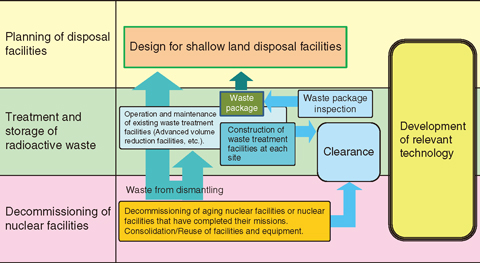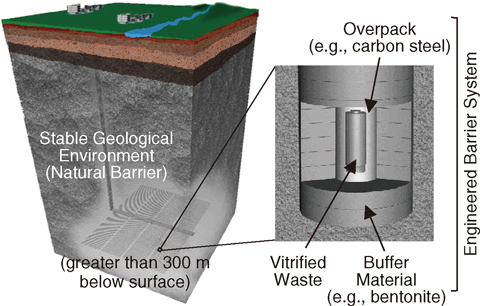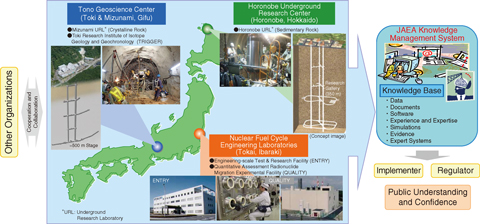
Fig.8-1 Outline of measures for the decommissioning of nuclear facilities and the treatment and disposal of radioactive waste

Fig.8-2 Schematic view of the basic concept for the geological disposal of high-level radioactive waste (HLW) in Japan

Fig.8-3 System for implementing JAEA R&D activities
Safe and efficient decommissioning of our nuclear facilities and treatment and disposal of radioactive wastes are important issues to consider in our research and development (R&D) activities. We are currently setting up systems to accomplish these goals and are also developing the related technologies (Fig.8-1).
Furthermore, we will be responsible for disposing of radioactive waste generated not only from our research facilities but also from universities, industrial facilities, and other sites.
R&D for the decommissioning of nuclear facilities
We have developed an engineering system for decommissioning and an evaluation system for clearance. It is important to assess the applicability of these systems to the decommissioning of our nuclear facilities such as the Fugen Nuclear Power Plant.
In the Fugen Nuclear Power Plant, to properly operate the clearance system, the target nuclides for evaluation were selected and a method for evaluating their radioactive concentrations was established (Topic 8-1).
The Ningyo-toge Environmental Engineering Center has been managing the Ningyo-toge Uranium Mine, now out of service for mining, in accordance with the mine safety law.
For the remediation of the Yotsugi Mill Tailings Pond multi-layered capping was constructed to reduce rainwater penetration to lower the burden of water treatment and to reduce radon exhalation and dose rates. Only natural materials have been used for the capping for long-term stability after remediation. As for the structure, multi-layered capping wherein each layer has a different purpose was adopted. At present, the monitoring of several items including the concentration rates of elements in the water has been continued to verify the effectiveness of the capping (Topic 8-2).
R&D for characterization of radioactive waste
For safe disposal of radioactive wastes, it is necessary to understand their nuclide compositions. Therefore, we developed related techniques to enable reasonable and effective analysis.
To reduce the radiation exposure of operators during an analytical procedure, a simple and rapid analytical method with capillary electrophoresis has been developed to measure the concentration of neodymium (Nd) contained in the radioactive waste.
According to this analytical method, Nd was separated from various coexisting elements and detected (Topic 8-3).
Disposal of low-level radioactive waste
Before radioactive wastes are disposed of, their radioactivity concentrations must be confirmed to be less than acceptance criteria for some important radioactive nuclides.
Therefore, appropriate evaluation methods for 16 radioactive nuclides in metal wastes generated from Japan Power Demonstration Reactor (JPDR) dismantling were established as a combination of the Scaling Factor method (SF method), the mean activity concentration method, and the theoretical method (Topic 8-4).
R&D to Improve Technology and Reliability of Geological Disposal in Japan
Geological disposal is one option for long-term isolation of high-level radioactive waste (HLW) produced during nuclear power generation from human environments. This is a critical issue with which the present generation must sensibly deal and it will remain crucial despite any revision of the national nuclear energy policy. In Japan, spent fuel from power reactors is reprocessed to extract reusable uranium (U) and plutonium (Pu) for power generation. The liquids separated from the spent fuel during chemical reprocessing are solidified into a stable glass form. Under the Japanese disposal concept, vitrified wastes are then encapsulated in a thick steel overpack surrounded by highly compacted bentonite and placed in a stable geological environment at more than 300 m below the surface (Fig.8-2). Implementing geological disposal of HLW is a long-term project that will last over 100 years. The project begins with site selection and continues to repository construction and operation, which will be followed by backfill for repository closure. It is thus of great importance to proceed efficiently with the project as a national responsibility by continuously improving its sound technical basis and applying these attitudes to implementation, regulatory activities, and, most importantly, enhancement of public confidence. To this end, we have made and will continue to make steady progress in R&D in various fields, including geoscience, repository engineering, and safety assessment, to improve the technologies used for reliable geological disposal in Japan.
At present, our R&D focuses specifically on projects at two underground research laboratories (URLs)-one at Mizunami, which researches crystalline rocks, and the other at Horonobe, which researches sedimentary formations (Fig.8-3). At the end of 2014, excavation of galleries at a depth of 500 m at Mizunami had been finished, and preparation of research galleries at a depth of 350 m at Horonobe had been completed. Multidisciplinary investigations are ongoing, because the reliability of various investigative techniques should be tested and verified before the site characterization program begins (Topics 8-5, 8-6, 8-7, and 8-8). In addition, studies on tectonics, volcanic and faulting activities, and the like are in progress to evaluate the long-term stability of geological environments in Japan (Topic 8-9). The Toki Research Institute of Isotope Geology and Geochronology (TRIGGER) was established in November 2014 for the development of dating techniques using advanced equipment for isotope geology and geochronology. In parallel with such geoscientific efforts, we are conducting an extensive study to assess the performance of the disposal system, of engineered barrier systems, and of the long-term chemistry and migration of radionuclides at Tokai to expand our knowledge base for geological disposal (Topics 8-10, 8-11, and 8-12). These studies exploit data and information about geological environments that were obtained through geoscientific research at both URLs. The prototype knowledge management system that was developed in 2010 is being improved to systematically provide and transfer multiple associated R&D results to both implementers and regulators and to ensure their safety. Furthermore, the results of the R&D activities have been summarized as an unconventional web-based report (CoolRepH26), which has been available on Japan Atomic Research Agency (JAEA)’s public website since March 2015.
Implementing Safety Measures at the TRP and Enhancing Reprocessing Technologies
After the Great East Japan Earthquake and the accident at the Fukushima Daiichi Nuclear Power Station of Tokyo Electric Power Company, Incorporated, various emergency safety measures were implemented at the Tokai Reprocessing Plant (TRP).
To reduce the probability of hazards at the TRP, efforts have been focused on solidifying and stabilizing the highly active liquid waste (HALW) at the Tokai Vitrification Facility and the Pu solution at the Plutonium Conversion Development Facility as soon as possible.
Vitrification of all the stored HALW is estimated to require two decades. Thus, an advanced glass melter is under development to make steady progress on the solidification and stabilization of the HALW.
For low-level radioactive effluents, a cement-based solidification method accompanying a nitrate-ion decomposition process has been developed to reduce the environmental impact.
As an effort to improve reprocessing technologies, the rate constant of Pu extraction has been studied using a microchip. The results obtained in this study indicate that the microchip can be an effective tool for studying the Pu rate constant as well as analyzing radioactive elements (Topic 8-13).